Menus
- THE twin-cylinder Ducati version 1100 cm3 in vintage 2009.
- Discovery
- In the saddle
- Contact
- In the city
- Highway
- National
- Departmental
- Braking
- Tires
- Comfort
- Consumption
- Convenient
- Conclusion
THE twin-cylinder Ducati version 1100 cm3 in vintage 2009.
The Ducati Monster is the flagship Ducati model declined in 2008 in 1100 cm3, in the tradition of the 696 more than in that of the 1000 S2R and other 900. With its new 1078 cm3, the Monster 1100 shows its claims: 95 horses at 7500 revs / min but above all a torque of 10.5 mkg at 6,000 rpm, of which 9.5 mkg available from 3,500 rpm ! All for a rikiki weight of only 169 kilos … in short, an 1100 engine for a 600 cm3 size. The power-to-weight ratio is a promise in itself !
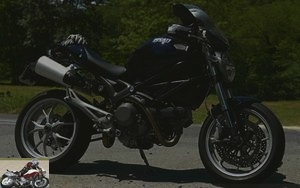
Discovery
In 2009, the Monster 1100 is available in gray, red and black. While purists of the brand will prefer the red version, the glossy black is elegant, especially since the tank and the seat cowl have matte black parts. The 1100 looks like the 696 to be mistaken on the outside, in particular with the half-tubular half-cast aluminum frame, the front headlight cut from a curve, the "tank" with its meshed air intakes and the two flanking exhausts. saddle. You have to get closer to notice the differences. In terms of weight already, the 1100 is only 8 kilos more than the 696 but offers on the other hand 15 additional horses. We especially notice the superb single-sided swingarm which highlights a serrated wheel and a 180 rear tire! And when we take a closer look, we especially note a perfect finish at all levels..
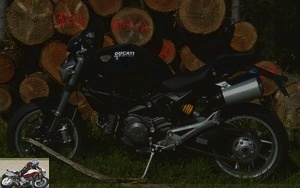
In the saddle
The feet touch the ground for the 1.70m rider due to a saddle perched at 810mm (770mm for the 696). Yet the motorcycle’s featherweight – lighter than many 600 roadsters – allows for easy access and handling. The pilot is immediately tilted forward with a fairly aggressive stance, almost sporty by the pressure on the wrists. The wide curved handlebars fall well under the hands. The saddle, hand and foot angle remains pleasant if not completely natural.
The dashboard lets guess a magnificent fully digital assembly with the tachometer overhanging the whole. Clock, totalizer, partial trip, reserve trip, battery voltage, chrono, shiftlight, DDA (Ducati Data Analysis) pre-equipped…. we would just have liked to find a fuel gauge there. It’s nice but, with the driving position, quite inconspicuous. In fact, looking at both the meter and the road is difficult.
The mirrors are easily adjusted with a light direct pressure on the mirror. They rather offer a good field of vision and above all do not vibrate.
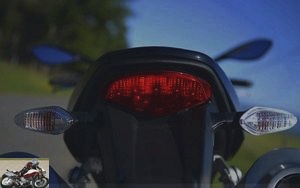
Contact
The twin-cylinder’s "Desmodue" block snorts with a magnificent hoarse, deep sound. It’s an 1100 and not a 696. The sound of this bike is a melody in itself that prompts you to turn the grip. The first meters are almost brutal … it sends strong immediately! Let go of the throttle and the Monster 1100 seems to hit a wall with its massive engine brake. The Monster asks to act gently on the throttle, both in acceleration and especially in deceleration. And then the Monster gets tamed … actually very quickly.
The gearbox is precise and without dead point. The clutch lever is almost smooth compared to its predecessors. Goodbye wrist training sessions.
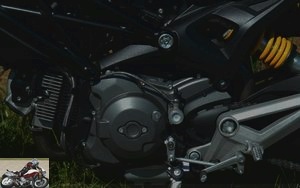
In the city
The Monster slips easily between the lines. Straightforward, manly picks get you out of circulation in less time than it takes to say it. In fact, the former proves to be extremely limited in both acceleration and deceleration and capable of taking you up to 85 km / h at the switch. A simple release of gas and you are crushed against the tank. On the next gear, in seconds, you have to make sure you are above 45 km / h and 3,000 rpm so that it stops knocking. We are of course not talking about winding in the last gear, impossible under 60 km / h. And at 60 km / h, we’re still shaken like a plum tree.
The box is very nice and precise, even if the handle requires a good grip. Suddenly, we will systematically come back to neutral at the lights, under penalty of tiring the left wrist very quickly..
In town, the Monster heats up quite quickly…. especially because of its engine architecture which places one of the cylinders under the saddle. The heat then rises easily and quickly between the thighs and you can quickly get out of traffic jams, especially in the middle of summer.
As much as the Monster 696 does very well in the city, the Monster 1100 does not fit there at best. And yet, despite the picture, he accepts it easily, especially since the turning radius is much better than it has been. You just have to adopt it and adjust the clutch.

Highway
The Monster 1100 sets off with force and vigor on the motorway, especially since the screen associated with a driving position on the front, provides good protection up to 160 km / h (on German motorway ). At this speed, the Monster is either in 3rd at the breaker, or at only 5,000 rpm on the last gear, or at 4,000 rpm from the breaker. The behavior of the bike is imperial, with both a perfect stability in a straight line, and an ease to take the big curves. In short, the Monster would almost appreciate the highway, an extremely rare fact for a roadster.
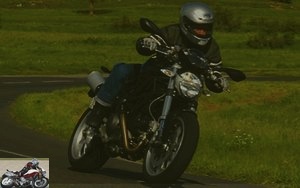
National
The fact remains that the Monster 1100 is happy to return to the nationals to oscillate between 3rd and 4th gear; he even agrees to wrap up on 6th gear. It can then stay in this gear almost anywhere, including through places limited to 70 km / h, when the Monster is only spinning at 2,000 rpm..
But the ideal rate remains between 4,500 and 7,000 rpm. The twin really bangs at 2,000 rpm and growls at 3,000 rpm. It gets really nice and lively at 4,000 rpm, with a real kick in at 5,000 rpm. It then breaks between 8,000 and 9,000 rpm. Its true speed range is therefore mainly between 4,500 and 7,500 rpm while offering a much wider possible availability.
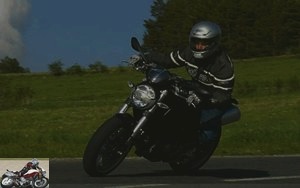
Departmental
These are the departmental that the Monster particularly likes. It fits here really easily in the turns and goes through the angle changes quickly. It then offers a healthy, sporty and particularly precise behavior. The tubular trellis frame and aluminum buckle have a lot to do with it and provide exemplary rigidity that allows almost anything. Suddenly, the Monster allows to accelerate the pace in a notable way and to stay between the 2nd and 3rd reports…. which pushes each other to 125 and 165 km / h respectively (not in France). The Monster reacts to the slightest request of the gas with lyrical flights … The mountain passes are linked together at high speed and the smallest pins follow each other without fatigue or particular effort … except perhaps in the shoulders, especially downhill. Attention is only awakened when the coating begins to deteriorate, highlighting a lack of progressiveness in the shock absorber. The ideal trajectory is then not held as perfectly as on the pool table. But it is already necessary to drive very hard to perceive these first limits.
And that’s when we realize that ground clearance is very, very important … limits impossible to find, even at a very sustained pace..
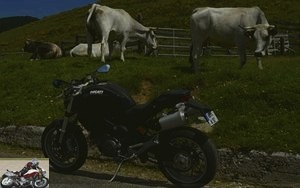
Braking
The front brake offers power and feeling, without being violent, with its Brembo 4-piston radial-mount calipers. The rear brake just fulfills its role of retarder, ideal in town. In fact, the rear brake is even sufficient in town and outskirts. Everything is easily handled without special attention. The forward leaning position just results in a little more physical braking for the arms and shoulders.
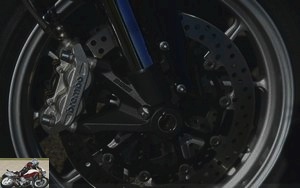
Tires
The original BT16s provide a good compromise between road and sport tire. They hang very well.
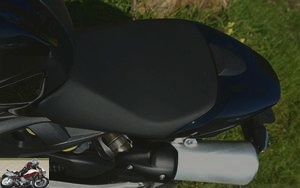
Comfort
The saddle appears firm but the suspensions smooth out the irregularities of the road in coiled driving. Suddenly, it is possible to make journeys of more than 300 km without suffering. It is therefore more comfortable than the 696 in comparison.
The passenger, on the other hand, has no grab handle. In any case, there is limited space at the back and not very suitable for anything other than a city race. The Monster is not made to accommodate a passenger. Suddenly, the seat cowl is essential and the most beautiful effect. In short,
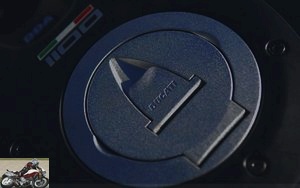
Consumption
The Monster is capable of the worst and the best, depending on the mood and conduct of its rider. The most furious will see the reserve indicator light up before 200 km and the reels will only see it appear at 270 km! Suddenly, the Monster can titillate the 300 km of autonomy with an average consumption hovering around 5.5 liters.

Convenient
The tank is plastic and does not allow a magnetic bag. There are no sticking points at the back. There is no room under the saddle. There is still the possibility of purchasing a U support. In summary, the loading possibilities are more than limited.
The crutch does not fall easily under the foot and is not the easiest to grab. Once in place, it is perfect.
The positive point lies in the central plastic part of the tank which plays the role of protection against the zippers of the jacket, thus avoiding scratching the paint: well seen !
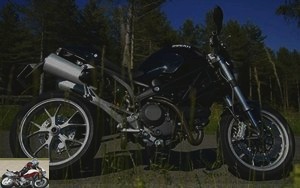
Conclusion
As much as the Monster 696 could be put in all hands, the Monster 1100 is more manly, with much more character. This character tends to push towards a sportier, more dynamic drive, needing space to express its full potential…. and he has! He readily accepts long trips and is particularly fond of bleeding arsouilles, all with vocalizations to make many Italians blush. In fact, the engine of the Monster 1100 is a treat that is matched only by its chassis, with perfectly adapted braking. At 11,200 euros, the price is finally in the middle of the category of big roadsters.
Strong points
- motor
- cycle part
- maneuverability
- box
Weak points
- barely readable counter block
- duo
- practical aspects
Competitors: Aprilia Tuono, BMW R1200R, Ducati 1100 Monster Evo, Honda CB 1000 R, Honda CB 1300, Kawasaki Z 1000, Moto Guzzi 1200 Sport V8, Suzuki
Bandit 1200, Suzuki GSX 1400, Yamaha Fazer 1000, Yamaha XJR 1300
Ducati Monster technical sheet
Related articles
-
Ducati Monster 796 motorcycle test
Bolognese sauce made from 696 and 1100 The saga continues with the Monster 796, which appeared with surprise in 2010, but with an L-shaped twin fitted to…
-
Ducati Monster 696 motorcycle test
600, 620, 695, then 696, the Monster is above all THE Ducati twin. After 15 years of development, the Monster underwent a real makeover in 2008: new…
-
Ducati Hypermotard 1100 and 1100S motorcycle test
THE 1100 cc Ducati twin-cylinder in 2009 vintage supermot version. Better known in the niche of the big roadster, Ducati offers its 1100 cm3 vtwin in a…
-
Ducati Hypermotard 796 motorcycle test
The Ducati 796 twin-cylinder in 2010 vintage supermot version. The Ducati Hypermotard 796 is the variation of the Hypermotard 1100, presented at the…
-
Ducati 848 motorcycle test – 134 horsepower in free version
The Ducati 848 is the mid-size sports car of the Italian brand, evolution of the 749, halfway between the 696 cm3 of a Monster and the 1198 cm3 of its…
-
Ducati Monster 1100S motorcycle test
THE twin-cylinder Ducati version 1100 cm3 in vintage 2009. Rediscovering a myth is always a pleasure tinged with apprehension: can a new monster be more…
-
A mechanical celebration of the famous CB 750 Four, the CB 1100 combines neo-retro aesthetics and current performance. Without sacrificing anything on…
-
Ducati 1098 motorcycle test – 160 hp in free version
There are times in a biker life where the emotional strikes, in the heart ! I remember when the 916 was released : what a slap! A stroke of genius signed…
-
Ducati 350 SCD motorcycle test
From the circuit to the road for the Italian sportswoman 4-stroke single cylinder, 340 cc, 42 hp, 210 km / h, 112 kg dry In 1954, the arrival of Fabio…
-
Honda CMX 1100 Rebel motorcycle test
The big one who has everything of a small one 1,084 cc in-line twin, 64 kW / 87 hp at 7,000 rpm, 98 Nm at 4,750 rpm, 10,499 euros In the 1100 family, I…